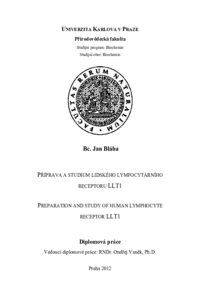Příprava a studium lidského lymfocytárního receptoru LLT1
Preparation and study of human lymphocyte receptor LLT1
diplomová práce (OBHÁJENO)

Zobrazit/
Trvalý odkaz
http://hdl.handle.net/20.500.11956/43528Identifikátory
SIS: 92349
Katalog UK: 990014815580106986
Kolekce
- Kvalifikační práce [21483]
Autor
Vedoucí práce
Konzultant práce
Bezouška, Karel
Oponent práce
Konvalinka, Jan
Fakulta / součást
Přírodovědecká fakulta
Obor
Biochemie
Katedra / ústav / klinika
Katedra biochemie
Datum obhajoby
28. 5. 2012
Nakladatel
Univerzita Karlova, Přírodovědecká fakultaJazyk
Čeština
Známka
Výborně
Klíčová slova (česky)
rekombinantní exprese, transientní transfekce, HEK293, přirozené zabíječské buňky, LLT1, CLEC2D, rentgenová strukturní analýzaKlíčová slova (anglicky)
recombinant expression, transient transfection, HEK293, natural killer cells, LLT1, CLEC2D, X-ray crystallographyPřirozené zabíječské buňky (NK buňky) jsou pro svojí schopnost rozpoznat a přivodit buněčnou smrt nádorovým a virem infikovaným buňkám bez předchozí antigenní senzitizace intenzivně studovanou součástí imunitního systému. Jejich imunitní funkce je regulována signály vyvolanými interakcí povrchových stimulačních a inhibičních receptorů s ligandy přítomnými na cílové buňce. Současný výzkum receptorů NK buněk C-lektinového typu ukázal, že jejich ligandy se nacházejí v rámci stejné proteinové rodiny, popisující tak receptor-ligandovou interakci dvou lektinů. Je tomu tak i v případě inhibičního receptoru lidských NK buněk NKRP1 (gen KLRB1) a jeho ligandu LLT1 (gen CLEC2D). Imunologické studie popisují ochranu nádorových buněk před imunitním systémem zvýšenou expresí receptoru LLT1 nádorovými buňkami nebo sníženou expresí receptoru NKRP1 na NK buňkách. Tato diplomová práce popisuje úspěšnou produkci rozpustné formy LLT1 metodou rekombinantní exprese v lidských embryonálních ledvinných buňkách (HEK 293). Ukazuje, že lichý počet cysteinů obsažených v rámci extracelulární lektinové domény LLT1 způsobuje agregaci a špatné sbalení proteinu. Rozpustná forma LLT1 byla stabilizována obnovením šestého cysteinu v evolučně konzervované pozici přístupem cílené mutageneze. Tvorba třetího disulfidického můstku byla...
Natural killer (NK) cells are an intensively studied part of immune system, possessing unique ability to recognize and induce death of tumor and virus-infected cells without prior antigen sensitization. Their function is regulated by a fine balance of signals induced by multiple activating and inhibitory cell surface receptors and their interaction with the ligands present on the target cell. Recent research in their C-type lectin-like receptors repertoire has shown that ligands of some of these previously orphan receptors lie within their own family, describing a lectin-lectin interaction. This is the case of human inhibitory receptor NKRP1 (gene KLRB1) and its ligand LLT1 (gene CLEC2D). Previous studies have shown that overproduction of LLT1 in cancer cells or lower production of NKRP1 in NK cells is connected to cancerous manifestations. This master's thesis shows a successful production of the extracellular part of LLT1 utilizing a mammalian expression system based on transient transfection of modified human embryonic kidney (HEK) cell lines. It was found that the five cystein residues contained within the lectin domain of LLT1 tend to cause misfolding and formation of aggregates. Stabilization of the domain was achieved by restoration of the sixth cystein residue at the evolutionary conserved...
